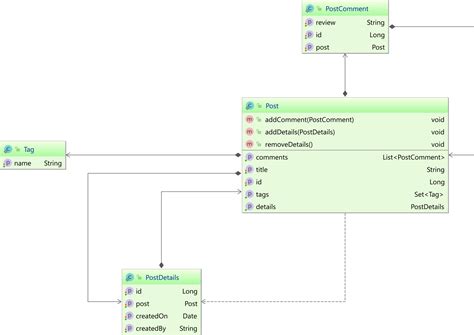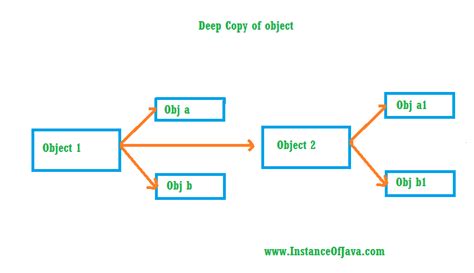spring boot clone object | How to Make a Deep Copy of an Object in Java spring boot clone object If you want to deep copy an object you will have to traverse the object graph and copy each child object explicitly via the object's copy constructor or a static factory method that in turn deep copies the child object. Hot Topic. How to make Eggs Guide in Pokemon Scarlet and Violet (Pokemon SV).See how to hatch eggs, food with Egg Power levels, recommended locations and abilities to hatch eggs and more! Table of Contents. How To Make Eggs. └ Use Egg Power To Hatch Eggs Faster. How To Hatch Eggs. └ Recommended .
0 · java
1 · The best way to clone or duplicate an entity with JPA and Hibernate
2 · Lombok • Builders and Copy Constructors
3 · Java: recommended solution for deep cloning/copying an instance
4 · Java Copy Constructor
5 · How to Make a Deep Copy of an Object in Java
6 · How to Clone a JPA Entity
7 · How does SpringBoot copy objects? Old birds play like this!
8 · How do you make a deep copy of an object?
9 · Advanced Java: Simplifying Object Property Copy and
Phone Cases. Bumper Pallas Iphone 15 Pro. $560.00. Bumper Pallas Iphone 15 Pro Max. $560.00. Bumper Pallas Iphone 15 Pro. $560.00. Fold Me Pouch. $1,690.00. Bumper Pallas Iphone 14 Pro. $585.00. Iphone X & XS Folio. $525.00. Louis Vuitton’s range of phone cases, bumpers and folios for women combine function with fashion.
When we want to copy an object in Java, there are two possibilities that we need to consider, a shallow copy and a deep copy. For the shallow copy approach, we only copy field values, therefore the copy might be dependant on the original object. The simplest approach to clone an entity is to manually copy its fields. We can either use a constructor or a method that explicitly sets each field value. This gives us full control over what is copied and how relationships are handled. Let’s create the Product entity and Category entity classes: @Entity public class Category { private Long id; If you want to deep copy an object you will have to traverse the object graph and copy each child object explicitly via the object's copy constructor or a static factory method that in turn deep copies the child object. When cloning or duplicating an entity, using a copy constructor is the best way to control what properties and associations need to be retained by the cloned copy. Without explicitly choosing what needs to be cloned, subtle bugs may occur especially if bidirectional associations are not properly synchronized .
As mentioned in the comments to the accepted answer, detatch will ignore unflushed changes to the managed entity. If you are using spring you have another option which is to use org.springframework.beans.BeanUtils. Here you have BeanUtils.copyProperties(Object source, Object target). This will allow you to do a shallow copy without tampering . A copy constructor in a Java class is a constructor that creates an object using another object of the same Java class. That’s helpful when we want to copy a complex object that has several fields, or when we want to make a deep copy of an existing object. 2. How to Create a Copy Constructor. For shallow cloning (clones only the first level properties): commons-beanutils BeanUtils - in most cases. Spring BeanUtils - if you are already using spring and hence have this utility on the classpath. During the query operation, after the Service layer queries the DO object, it needs to convert the DO object into VO object, and then return it to the front end through the Controller layer for rendering. This involves a lot of object conversion.
BeanUtil is a widely used Java utility class that provides a series of methods to simplify property copying and manipulation between JavaBean objects. It primarily addresses complex object operations and property handling issues, significantly improving code readability and maintainability. Copy constructors allow a new object to be created from an existing object of the same class, as a copy of an existing object. If this operation is beneficial for a particular business process is executing a few copies. Copy constructors are newly instantiated objects that are independent of the original instance. When we want to copy an object in Java, there are two possibilities that we need to consider, a shallow copy and a deep copy. For the shallow copy approach, we only copy field values, therefore the copy might be dependant on the original object.
The simplest approach to clone an entity is to manually copy its fields. We can either use a constructor or a method that explicitly sets each field value. This gives us full control over what is copied and how relationships are handled. Let’s create the Product entity and Category entity classes: @Entity public class Category { private Long id; If you want to deep copy an object you will have to traverse the object graph and copy each child object explicitly via the object's copy constructor or a static factory method that in turn deep copies the child object. When cloning or duplicating an entity, using a copy constructor is the best way to control what properties and associations need to be retained by the cloned copy. Without explicitly choosing what needs to be cloned, subtle bugs may occur especially if bidirectional associations are not properly synchronized .
As mentioned in the comments to the accepted answer, detatch will ignore unflushed changes to the managed entity. If you are using spring you have another option which is to use org.springframework.beans.BeanUtils. Here you have BeanUtils.copyProperties(Object source, Object target). This will allow you to do a shallow copy without tampering . A copy constructor in a Java class is a constructor that creates an object using another object of the same Java class. That’s helpful when we want to copy a complex object that has several fields, or when we want to make a deep copy of an existing object. 2. How to Create a Copy Constructor. For shallow cloning (clones only the first level properties): commons-beanutils BeanUtils - in most cases. Spring BeanUtils - if you are already using spring and hence have this utility on the classpath. During the query operation, after the Service layer queries the DO object, it needs to convert the DO object into VO object, and then return it to the front end through the Controller layer for rendering. This involves a lot of object conversion.

java
BeanUtil is a widely used Java utility class that provides a series of methods to simplify property copying and manipulation between JavaBean objects. It primarily addresses complex object operations and property handling issues, significantly improving code readability and maintainability. Copy constructors allow a new object to be created from an existing object of the same class, as a copy of an existing object. If this operation is beneficial for a particular business process is executing a few copies. Copy constructors are newly instantiated objects that are independent of the original instance. When we want to copy an object in Java, there are two possibilities that we need to consider, a shallow copy and a deep copy. For the shallow copy approach, we only copy field values, therefore the copy might be dependant on the original object. The simplest approach to clone an entity is to manually copy its fields. We can either use a constructor or a method that explicitly sets each field value. This gives us full control over what is copied and how relationships are handled. Let’s create the Product entity and Category entity classes: @Entity public class Category { private Long id;
If you want to deep copy an object you will have to traverse the object graph and copy each child object explicitly via the object's copy constructor or a static factory method that in turn deep copies the child object.
When cloning or duplicating an entity, using a copy constructor is the best way to control what properties and associations need to be retained by the cloned copy. Without explicitly choosing what needs to be cloned, subtle bugs may occur especially if bidirectional associations are not properly synchronized .
As mentioned in the comments to the accepted answer, detatch will ignore unflushed changes to the managed entity. If you are using spring you have another option which is to use org.springframework.beans.BeanUtils. Here you have BeanUtils.copyProperties(Object source, Object target). This will allow you to do a shallow copy without tampering . A copy constructor in a Java class is a constructor that creates an object using another object of the same Java class. That’s helpful when we want to copy a complex object that has several fields, or when we want to make a deep copy of an existing object. 2. How to Create a Copy Constructor.
For shallow cloning (clones only the first level properties): commons-beanutils BeanUtils - in most cases. Spring BeanUtils - if you are already using spring and hence have this utility on the classpath. During the query operation, after the Service layer queries the DO object, it needs to convert the DO object into VO object, and then return it to the front end through the Controller layer for rendering. This involves a lot of object conversion.

BeanUtil is a widely used Java utility class that provides a series of methods to simplify property copying and manipulation between JavaBean objects. It primarily addresses complex object operations and property handling issues, significantly improving code readability and maintainability.

nike tech fleece vest grijs

The best way to clone or duplicate an entity with JPA and Hibernate
Laureate Platform Chelsea Boot. $1,480.00. Item Unavailable. LOUIS VUITTON Official USA site - Discover our latest Laureate Platform Chelsea Boot, available exclusively on louisvuitton.com and in Louis Vuitton stores.
spring boot clone object|How to Make a Deep Copy of an Object in Java


























